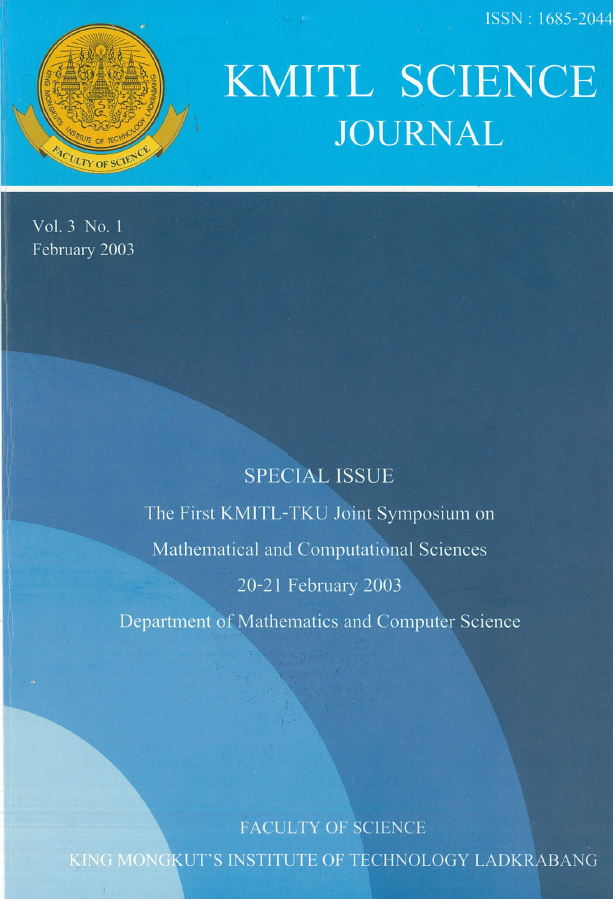A Branch-and-Bound Algorithm for Natural Language Database Query Using Metadata Search
Main Article Content
Abstract
This paper presents a branch-and-bound algorithm to process free-text natural language database queries based on the metadata search approach. The approach uses a metadata reference dictionary represented in a semantic graph of enterprise databases. User words, query cases, information models, and database values are vertices of the graph. The paper concludes with possible extensions to offer a full capability of free-text natural language database queries.
Keywords: -
E-mail: cast@kmitl.ac.th
Article Details
Copyright Transfer Statement
The copyright of this article is transferred to Current Applied Science and Technology journal with effect if and when the article is accepted for publication. The copyright transfer covers the exclusive right to reproduce and distribute the article, including reprints, translations, photographic reproductions, electronic form (offline, online) or any other reproductions of similar nature.
The author warrants that this contribution is original and that he/she has full power to make this grant. The author signs for and accepts responsibility for releasing this material on behalf of any and all co-authors.
Here is the link for download: Copyright transfer form.pdf
References
[2] Boonjing, V. and Hsu C. 2002. Metadata Search: A New Approach to Natural Language Database Interfaces. Proceedings IASTED International Conference on Information Systems and Databases. Tokyo, Japan.
[3] Hsu, C. Bouziane, M. Ratter, L. and Yee, L. 1991. Information Resources Management in Heterogeneous, Distributed Environments: A Metadatabase Approach. IEEE Tran. On Software Engineering Vol. 17 No. 6: pp. 604-625.
[4] He Hong, et al., Herb and Animal Medicine and Their Growing and Processing Technique (Jindun Press, 2001), 79-83.
[5] Hsu, C. 1996. Enterprise Integration and Modeling: the Metadatabase Approach. Boston: Kluwer Academic Publishers.
[6] Bouziane, M. and Hsu C. 1997. A Rulebase Management System Using Conceptual Modeling. J. Artificial Intelligence Tools Vol. 6 No. 1: pp. 37-61.
[7] Babin, G. and Hsu C. 1996. Decomposition of Knowledge for Concurrent Processing. IEEE Trans. Knowledge and Data Engineeing Vol. 8 No. 5: pp. 758-772.
[8] Cheung, W. and Hsu C. 1996. The Model-Assisted Global Query System for Multiple Database in Distributed Enterprises. ACM Trans. on Information Systems Vol. 14 No. 4: pp. 482-470.
[9] Hsu C. Tao Y., Bouziane M., and Babin G. 1993. Paradigm Translations in Integrating Manufacturing Information Using a Meta-Model: the TSER Approach. J. Information Systems Engineering Vo. 1 No. 1: pp. 325-352.
[10] Johnson, J.A. 1995. Semantic Relatedness. Computers Math. Applic, Vol. 29 No. 5: pp. 51-63.
[11] Wald, J.A. and Sorenson. 1984. Resolving the Query Inference Problem using Steiner Trees. ACM Transactions on Database Systems Vol. 9 No. 3: pp. 348-368.
[12] Kumar, V. 1987. Branch-and-Bound Search. In S.C. Shapiro (ed), Encyclopedia of Artificial Intelligence. New York: Wiley-Interscience.
[13] Nau, D.S. Kumar, V. and Kanal, L. 1984. General Branch and Bound, and its Relation to A* and AO*. Artificial Intelligence Vol. 23: pp.29-58.


